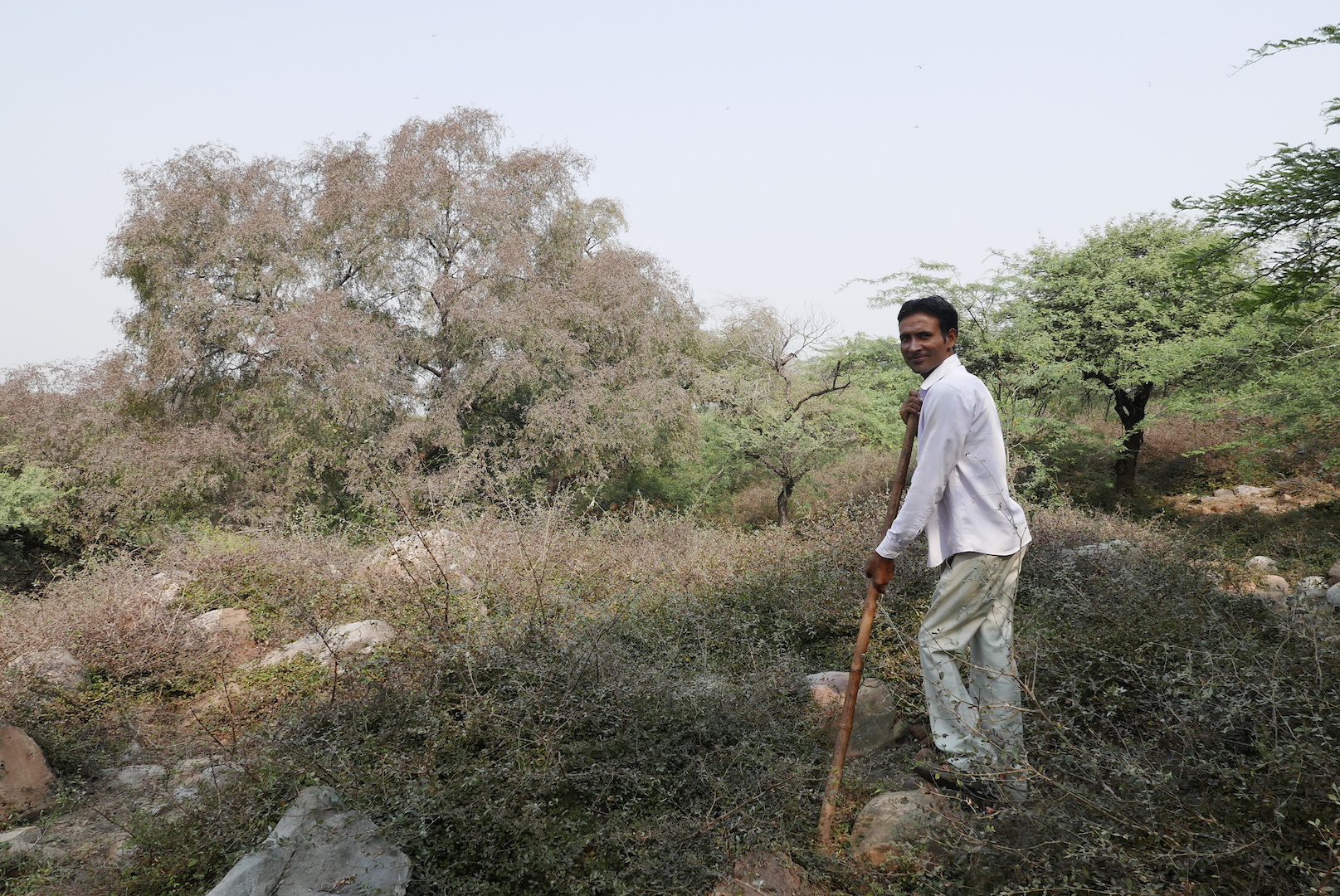 Listen to this article
•
15:34 min
Listen to this article
•
15:34 min
Walking into Mangar Bani feels like entering a time warp. Located along the Delhi-Haryana border, between Faridabad and Gurugram, this 250-hectare forest is something of an ecological relic that somehow survived despite the city’s efforts to encroach upon it. I soak in its undulating terrain, ancient trees, and rocky landscape, reminded that I am amidst the folds of one of the oldest mountain ranges in the world, the Aravallis that start near Delhi and end all the way in Gujarat.
A little over an hour from Connaught Place in Delhi, Mangar Bani is a dry, deciduous forest that transforms into a magical green during the monsoon. There are dhau trees, as well as dhak, raunjh, kumuth, pasendu, chirhaul, barna and kareel, local species of flora that shelter hyenas, leopards, porcupines, jackals, and monitor lizards, among hundreds of other animals. Mangar Bani and its adjoining green patches are a critical water-catchment area for Gurugram and Faridabad, and the last few green lungs of India’s choking capital city.
One of the main reasons that the Bani has survived, is because of the legend attached to it. Local pastoralists believe that it is a sacred grove protected by the spirit of the mystic Gudariyadas Baba, and any attempt to cut trees here will invite the Baba’s wrath.
The other reason it has survived is conservation work done by people like Sunil Harsana. Born in a village in Mangar, Sunil is an environmental activist who has been working towards conserving the region’s natural history for around 10 years now. He is the founder of the Mangar Eco Club, created in 2015, to introduce local and urban children to the biodiversity of the forest. He has been documenting the species here for the past six-seven years, and can rattle off the names of the diverse flora and fauna that inhabit this informal sanctuary.
On the day I visit, Sunil is accompanied by a group of children from villages located within the forest, who are also members of the club. When they see me peruse a copy of Birds of South Asia: The Ripley Guide, they figure I am here for the morning’s bird walk, and are palpably excited to share their knowledge with me. Their enthusiasm is infectious.

Environmental activist Sunil Harsana has been working to preserve the Mangar Bani forest for the past 10 years. Cover Photo Courtesy: Sunil Harsana
As we walk, Sunil tells me that the club has around 30-35 members, mostly children. Though they find it difficult to participate on school days, they are more than happy to help Sunil conduct outreach programmes on holidays. This arrangement works well. The kids have a role model in Sunil, who like them grew up in these forests, and has a healthy love of all things wild. Sunil in turn enjoys working with the children, and is “certain that their love for these forests will translate into a will to protect it in the future.”
We pause to observe a pair of spotted owlets, but try as I may, I cannot see them through my binoculars. “Aapne dekha, aapne dekha? (Did you see, did you see?)” one of the younger boys asks me. When I shake my head, he leads me to a better vantage point, so I can see the curious owls, and understand what the fuss is about. The boy is beaming, thrilled to have shown me the birds, and in that moment I realise the importance of Sunil’s work: By reconnecting the children with the biodiversity of Mangar Bani he is reviving the link between the community and their forest.
More than 245 species of birds, 20 species of mammals, and around 300 species of trees have been recorded here, and Sunil tells me the forest cover has increased since mining within the forest stopped in 2007. “Nature is self-repairing,” he says, “The forest is resurrecting itself and the population of wildlife is increasing, but the land-use change in the surrounding areas needs to be controlled.” The conversion of forest land to real estate is a serious concern, and is damaging the biodiversity and geology of the Aravalli ranges.
Sunil’s work extends far beyond nature walks. In addition to the eco club, he also nurtures the forest by building check dams before the monsoon every year, to prevent the erosion of soil. “If I see any illegal activities such as logging of trees happening in the surrounding forests, I report it to the forest department. If the department doesn’t take any action, I talk to the media and higher authorities,” he says.
Sunil knows that protection offered by local beliefs is not absolute. Since 2010 he has been fighting a battle for Mangar to be given forest status. He realises that his biodiversity documentation work is crucial towards this end, and is hopeful that revealing the splendours of this forest will convince the government to declare it a protected area.
The region was declared a no-construction zone in 2016, which has helped, but the encroachment of land for construction activities continues to plague the Aravalli Hills around Mangar Bani. Cara Tejpal, head of the Sanctuary Nature Foundation’s Mud on Boot’s Project that supports Sunil’s work, explains: “The very vulnerable forest of Mangar is subject to degradation, encroachment, and ‘development’ interests, despite being one of very few green patches that provides invaluable ecosystem services to the horrifically polluted National Capital Region.” She points out that Sunil’s work is in the interest of citizens of Delhi and Faridabad. “Sunil is a home-grown conservationist, and his relentless efforts to restore and protect the forest is inspiring,” she says.
It’s not just Mangar Bani that’s at stake. Sunil, who has explored the landscape extensively, states that there are areas in the surrounding forests where wildlife populations are thriving, but the government has proposed new roads through these areas. “The consequence of these roads will be human-wildlife conflict,” he laments.

Sunil works with a number of stakeholders, from locals in and around Mangar Bani, to citizen groups, activists, and journalists, to draw attention to the plight of this forgotten wilderness. “We engage with villagers, urbanites, and government departments. We try to talk to villagers initially. If an issue is not getting resolved, we talk to those from the city and the concerned government departments.”
Environmental analyst Chetan Agarwal, who was part of our motley group of birders that morning, appreciates Sunil’s multi-faceted approach, of using biodiversity documentation, awareness-building, and advocacy to garner support for a cause. “He is among a rare breed of conservationists,” he says.
Walking through the forest, I ponder over how local beliefs have shaped conservation in this region, and shaped Sunil’s relationship with the Bani. This little forest, engulfed on all sides by a fast-expanding city, is protected largely due to the sacred status afforded to it by locals. The surrounding forests do not enjoy this status, and they are sadly being encroached upon.
As we approach the end of the trail I realise that the children have disappeared. But I know they will return, to share the splendours of their forest with the next bunch of nature enthusiasts from the city, ably led by their pied piper. I take a deep breath of the clean air, feel the coolness of the wind, and hope for a larger Bani, that encompasses the surrounding hills.
The Mangar Eco Club offers free nature trails in Mangar Bani, every Sunday from 7 am – 10 am. To register, leave a message on their Facebook page.
Getting There: The best way to get to Mangar Bani is by road. From the Faridabad-Gurugram highway, take a turn for the road towards the Mangar Police Chowki. One can also take a metro or bus to Gurugram, and hire a taxi from there to Mangar Bani.






